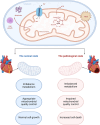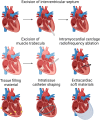Advances in preclinical surgical therapy of cardiovascular diseases
- PMID: 38701509
- PMCID: PMC11326035
- DOI: 10.1097/JS9.0000000000001534
Advances in preclinical surgical therapy of cardiovascular diseases
Abstract
Cardiovascular disease is the most common cause of death worldwide, resulting in millions of deaths annually. Currently, there are still some deficiencies in the treatment of cardiovascular diseases. Innovative surgical treatments are currently being developed and tested in response to this situation. Large animal models, which are similar to humans in terms of anatomy, physiology, and genetics, play a crucial role in connecting basic research and clinical applications. This article reviews recent preclinical studies and the latest clinical advancements in cardiovascular disease based on large animal models, with a focus on targeted delivery, neural regulation, cardiac remodeling, and hemodynamic regulation. It provides new perspectives and ideas for clinical translation and offers new methods for clinical treatment.
Copyright © 2024 The Author(s). Published by Wolters Kluwer Health, Inc.
Conflict of interest statement
The authors declare that they have no conflicts of interest.
Figures





References
-
- GBD Compare . https://vizhub.healthdata.org/gbd-compare/
-
- Vaduganathan M, Claggett BL, Jhund PS, et al. . Estimating lifetime benefits of comprehensive disease-modifying pharmacological therapies in patients with heart failure with reduced ejection fraction: a comparative analysis of three randomised controlled trials. Lancet 2020;396:121–128. - PubMed
-
- Nasr VG, Faraoni D, DiNardo JA, et al. . Association of hospital structure and complications with mortality after pediatric extracorporeal membrane oxygenation. Pediatr Crit Care Med 2016;17:684–691. - PubMed
-
- Emani SM, Piekarski BL, Harrild D, et al. . Autologous mitochondrial transplantation for dysfunction after ischemia-reperfusion injury. J Thorac Cardiovasc Surg 2017;154:286–289. - PubMed
Publication types
MeSH terms
LinkOut - more resources
Full Text Sources

